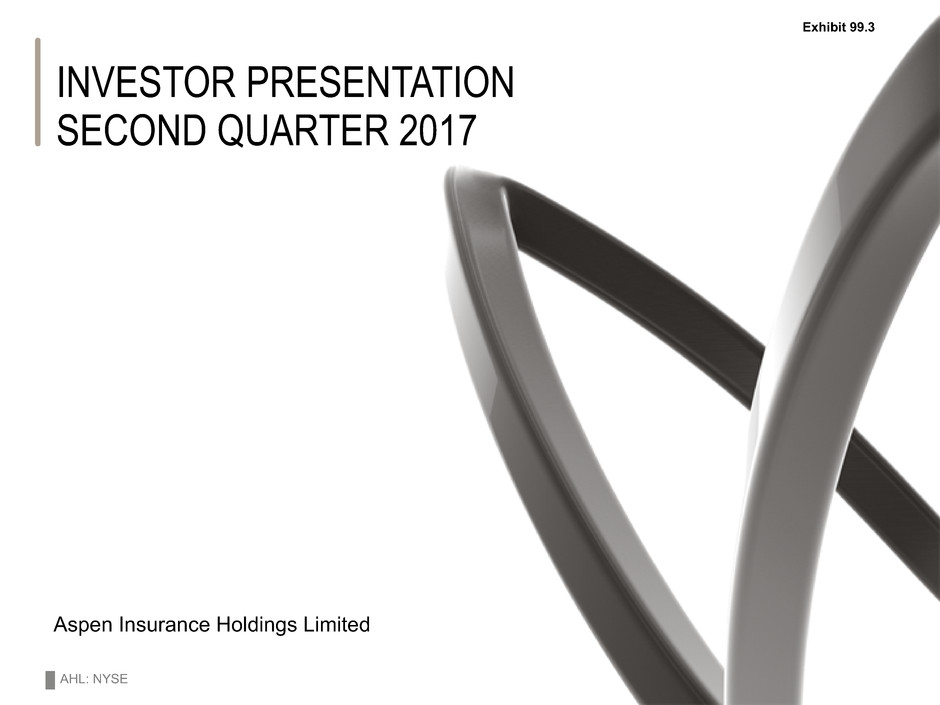
AHL: NYSE INVESTOR PRESENTATION SECOND QUARTER 2017 Aspen Insurance Holdings Limited Exhibit 99.3
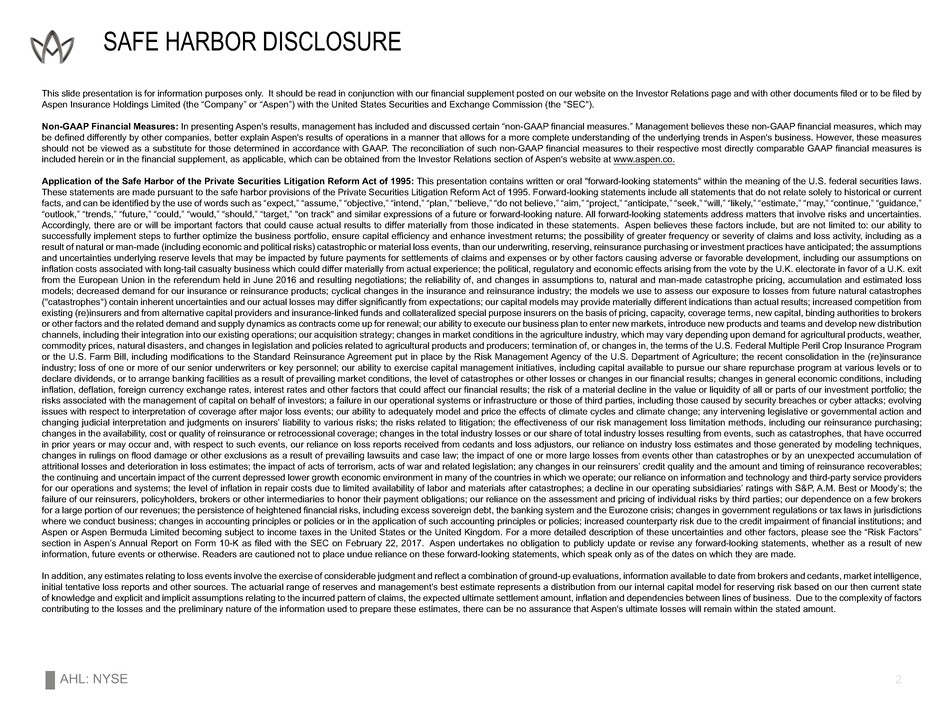
AHL: NYSE SAFE HARBOR DISCLOSURE This slide presentation is for information purposes only. It should be read in conjunction with our financial supplement posted on our website on the Investor Relations page and with other documents filed or to be filed by Aspen Insurance Holdings Limited (the “Company” or “Aspen”) with the United States Securities and Exchange Commission (the "SEC"). Non-GAAP Financial Measures: In presenting Aspen's results, management has included and discussed certain “non-GAAP financial measures.” Management believes these non-GAAP financial measures, which may be defined differently by other companies, better explain Aspen's results of operations in a manner that allows for a more complete understanding of the underlying trends in Aspen's business. However, these measures should not be viewed as a substitute for those determined in accordance with GAAP. The reconciliation of such non-GAAP financial measures to their respective most directly comparable GAAP financial measures is included herein or in the financial supplement, as applicable, which can be obtained from the Investor Relations section of Aspen's website at www.aspen.co. Application of the Safe Harbor of the Private Securities Litigation Reform Act of 1995: This presentation contains written or oral "forward-looking statements" within the meaning of the U.S. federal securities laws. These statements are made pursuant to the safe harbor provisions of the Private Securities Litigation Reform Act of 1995. Forward-looking statements include all statements that do not relate solely to historical or current facts, and can be identified by the use of words such as “expect,” “assume,” “objective,” “intend,” “plan,” “believe,” “do not believe,” “aim,” “project,” “anticipate,” “seek,” “will,” “likely,” “estimate,” “may,” “continue,” “guidance,” “outlook,” “trends,” “future,” “could,” “would,” “should,” “target,” "on track" and similar expressions of a future or forward-looking nature. All forward-looking statements address matters that involve risks and uncertainties. Accordingly, there are or will be important factors that could cause actual results to differ materially from those indicated in these statements. Aspen believes these factors include, but are not limited to: our ability to successfully implement steps to further optimize the business portfolio, ensure capital efficiency and enhance investment returns; the possibility of greater frequency or severity of claims and loss activity, including as a result of natural or man-made (including economic and political risks) catastrophic or material loss events, than our underwriting, reserving, reinsurance purchasing or investment practices have anticipated; the assumptions and uncertainties underlying reserve levels that may be impacted by future payments for settlements of claims and expenses or by other factors causing adverse or favorable development, including our assumptions on inflation costs associated with long-tail casualty business which could differ materially from actual experience; the political, regulatory and economic effects arising from the vote by the U.K. electorate in favor of a U.K. exit from the European Union in the referendum held in June 2016 and resulting negotiations; the reliability of, and changes in assumptions to, natural and man-made catastrophe pricing, accumulation and estimated loss models; decreased demand for our insurance or reinsurance products; cyclical changes in the insurance and reinsurance industry; the models we use to assess our exposure to losses from future natural catastrophes ("catastrophes") contain inherent uncertainties and our actual losses may differ significantly from expectations; our capital models may provide materially different indications than actual results; increased competition from existing (re)insurers and from alternative capital providers and insurance-linked funds and collateralized special purpose insurers on the basis of pricing, capacity, coverage terms, new capital, binding authorities to brokers or other factors and the related demand and supply dynamics as contracts come up for renewal; our ability to execute our business plan to enter new markets, introduce new products and teams and develop new distribution channels, including their integration into our existing operations; our acquisition strategy; changes in market conditions in the agriculture industry, which may vary depending upon demand for agricultural products, weather, commodity prices, natural disasters, and changes in legislation and policies related to agricultural products and producers; termination of, or changes in, the terms of the U.S. Federal Multiple Peril Crop Insurance Program or the U.S. Farm Bill, including modifications to the Standard Reinsurance Agreement put in place by the Risk Management Agency of the U.S. Department of Agriculture; the recent consolidation in the (re)insurance industry; loss of one or more of our senior underwriters or key personnel; our ability to exercise capital management initiatives, including capital available to pursue our share repurchase program at various levels or to declare dividends, or to arrange banking facilities as a result of prevailing market conditions, the level of catastrophes or other losses or changes in our financial results; changes in general economic conditions, including inflation, deflation, foreign currency exchange rates, interest rates and other factors that could affect our financial results; the risk of a material decline in the value or liquidity of all or parts of our investment portfolio; the risks associated with the management of capital on behalf of investors; a failure in our operational systems or infrastructure or those of third parties, including those caused by security breaches or cyber attacks; evolving issues with respect to interpretation of coverage after major loss events; our ability to adequately model and price the effects of climate cycles and climate change; any intervening legislative or governmental action and changing judicial interpretation and judgments on insurers’ liability to various risks; the risks related to litigation; the effectiveness of our risk management loss limitation methods, including our reinsurance purchasing; changes in the availability, cost or quality of reinsurance or retrocessional coverage; changes in the total industry losses or our share of total industry losses resulting from events, such as catastrophes, that have occurred in prior years or may occur and, with respect to such events, our reliance on loss reports received from cedants and loss adjustors, our reliance on industry loss estimates and those generated by modeling techniques, changes in rulings on flood damage or other exclusions as a result of prevailing lawsuits and case law; the impact of one or more large losses from events other than catastrophes or by an unexpected accumulation of attritional losses and deterioration in loss estimates; the impact of acts of terrorism, acts of war and related legislation; any changes in our reinsurers’ credit quality and the amount and timing of reinsurance recoverables; the continuing and uncertain impact of the current depressed lower growth economic environment in many of the countries in which we operate; our reliance on information and technology and third-party service providers for our operations and systems; the level of inflation in repair costs due to limited availability of labor and materials after catastrophes; a decline in our operating subsidiaries’ ratings with S&P, A.M. Best or Moody’s; the failure of our reinsurers, policyholders, brokers or other intermediaries to honor their payment obligations; our reliance on the assessment and pricing of individual risks by third parties; our dependence on a few brokers for a large portion of our revenues; the persistence of heightened financial risks, including excess sovereign debt, the banking system and the Eurozone crisis; changes in government regulations or tax laws in jurisdictions where we conduct business; changes in accounting principles or policies or in the application of such accounting principles or policies; increased counterparty risk due to the credit impairment of financial institutions; and Aspen or Aspen Bermuda Limited becoming subject to income taxes in the United States or the United Kingdom. For a more detailed description of these uncertainties and other factors, please see the “Risk Factors” section in Aspen’s Annual Report on Form 10-K as filed with the SEC on February 22, 2017. Aspen undertakes no obligation to publicly update or revise any forward-looking statements, whether as a result of new information, future events or otherwise. Readers are cautioned not to place undue reliance on these forward-looking statements, which speak only as of the dates on which they are made. In addition, any estimates relating to loss events involve the exercise of considerable judgment and reflect a combination of ground-up evaluations, information available to date from brokers and cedants, market intelligence, initial tentative loss reports and other sources. The actuarial range of reserves and management's best estimate represents a distribution from our internal capital model for reserving risk based on our then current state of knowledge and explicit and implicit assumptions relating to the incurred pattern of claims, the expected ultimate settlement amount, inflation and dependencies between lines of business. Due to the complexity of factors contributing to the losses and the preliminary nature of the information used to prepare these estimates, there can be no assurance that Aspen's ultimate losses will remain within the stated amount. 2
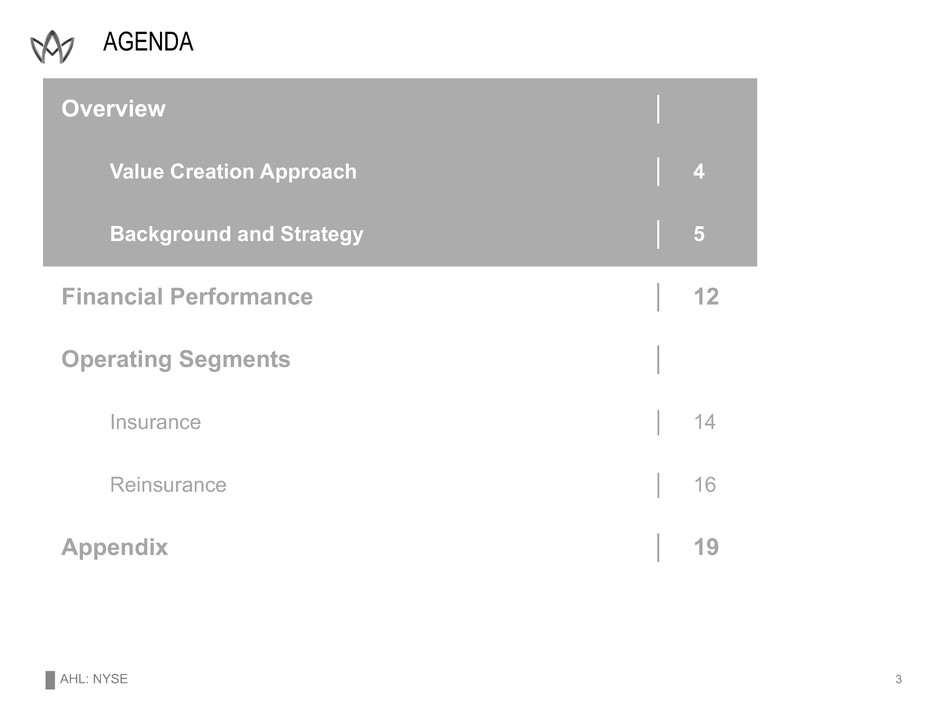
AHL: NYSE AGENDA 3 Overview │ Value Creation Approach │ 4 Background and Strategy │ 5 Financial Performance │ 12 Operating Segments │ Insurance │ 14 Reinsurance │ 16 Appendix │ 19
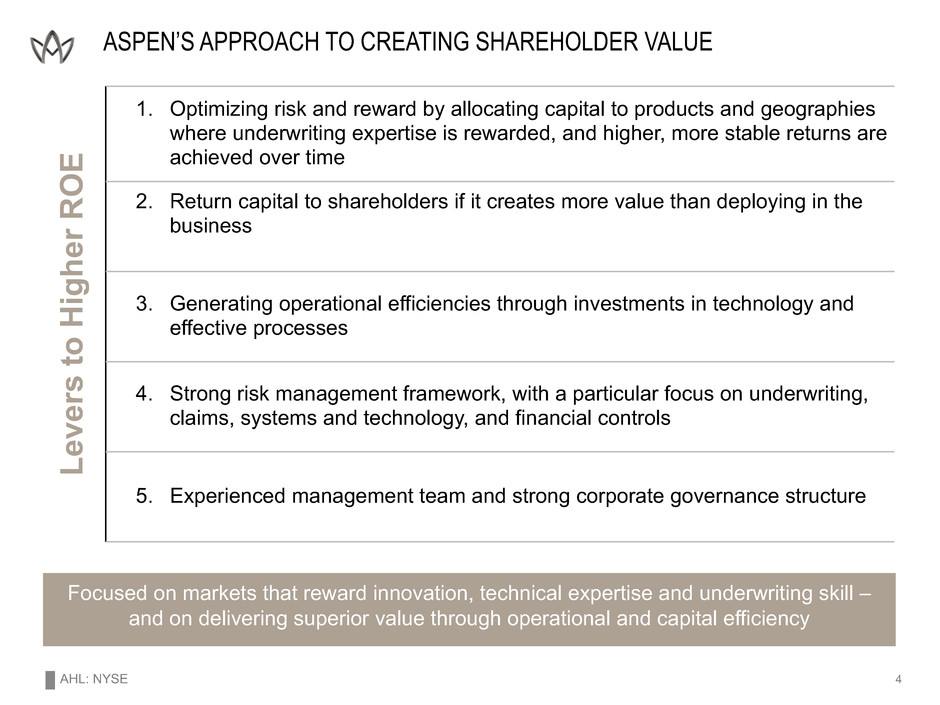
AHL: NYSE Levers to Higher RO E 1. Optimizing risk and reward by allocating capital to products and geographies where underwriting expertise is rewarded, and higher, more stable returns are achieved over time 2. Return capital to shareholders if it creates more value than deploying in the business 3. Generating operational efficiencies through investments in technology and effective processes 4. Strong risk management framework, with a particular focus on underwriting, claims, systems and technology, and financial controls 5. Experienced management team and strong corporate governance structure ASPEN’S APPROACH TO CREATING SHAREHOLDER VALUE Focused on markets that reward innovation, technical expertise and underwriting skill – and on delivering superior value through operational and capital efficiency 4
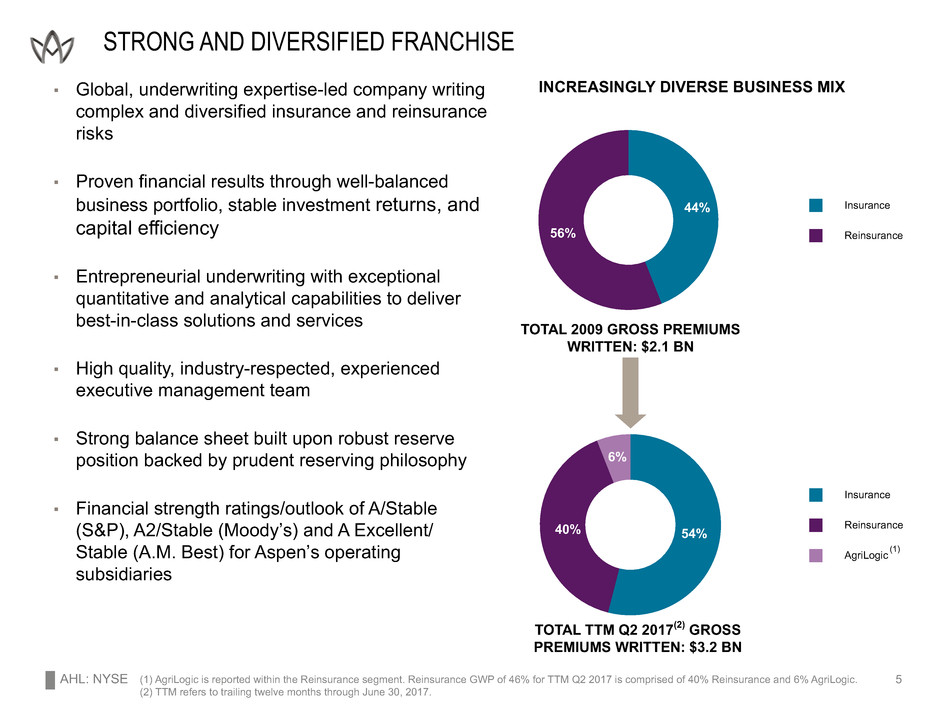
AHL: NYSE (1) AgriLogic is reported within the Reinsurance segment. Reinsurance GWP of 46% for TTM Q2 2017 is comprised of 40% Reinsurance and 6% AgriLogic. (2) TTM refers to trailing twelve months through June 30, 2017. Insurance Reinsurance AgriLogic 54%40% 6% STRONG AND DIVERSIFIED FRANCHISE ▪ Global, underwriting expertise-led company writing complex and diversified insurance and reinsurance risks ▪ Proven financial results through well-balanced business portfolio, stable investment returns, and capital efficiency ▪ Entrepreneurial underwriting with exceptional quantitative and analytical capabilities to deliver best-in-class solutions and services ▪ High quality, industry-respected, experienced executive management team ▪ Strong balance sheet built upon robust reserve position backed by prudent reserving philosophy ▪ Financial strength ratings/outlook of A/Stable (S&P), A2/Stable (Moody’s) and A Excellent/ Stable (A.M. Best) for Aspen’s operating subsidiaries 5 Insurance Reinsurance 44% 56% INCREASINGLY DIVERSE BUSINESS MIX TOTAL 2009 GROSS PREMIUMS WRITTEN: $2.1 BN ] TOTAL TTM Q2 2017(2) GROSS PREMIUMS WRITTEN: $3.2 BN (1)
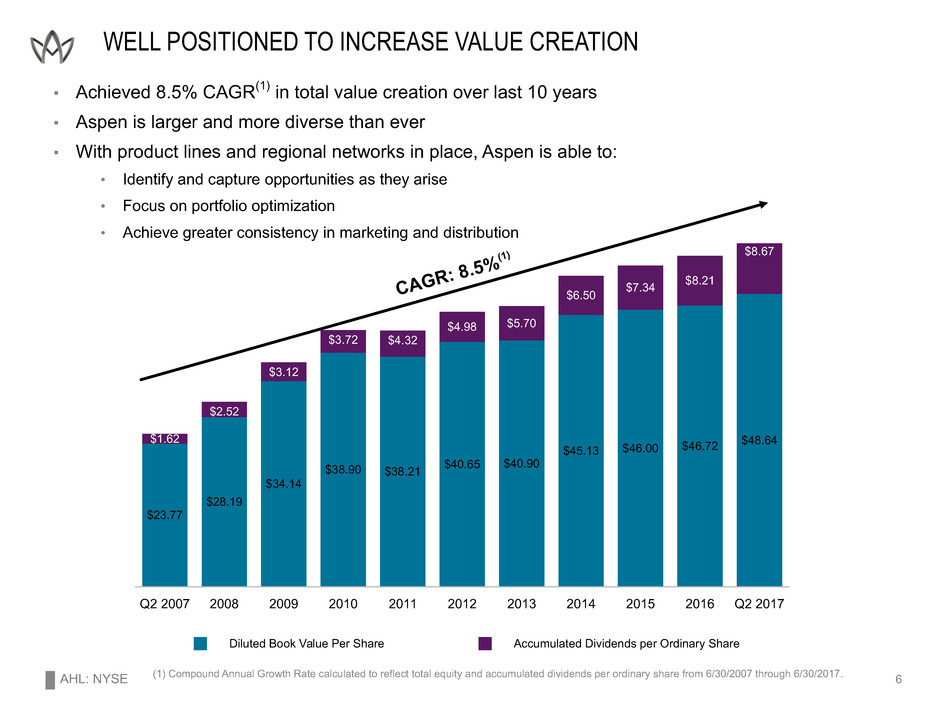
AHL: NYSE Diluted Book Value Per Share Accumulated Dividends per Ordinary Share Q2 2007 2008 2009 2010 2011 2012 2013 2014 2015 2016 Q2 2017 $23.77 $28.19 $34.14 $38.90 $38.21 $40.65 $40.90 $45.13 $46.00 $46.72 $48.64$1.62 $2.52 $3.12 $3.72 $4.32 $4.98 $5.70 $6.50 $7.34 $8.21 $8.67 ▪ Achieved 8.5% CAGR(1) in total value creation over last 10 years ▪ Aspen is larger and more diverse than ever ▪ With product lines and regional networks in place, Aspen is able to: • Identify and capture opportunities as they arise • Focus on portfolio optimization • Achieve greater consistency in marketing and distribution WELL POSITIONED TO INCREASE VALUE CREATION 6 CAGR: 8.5 %(1 ) (1) Compound Annual Growth Rate calculated to reflect total equity and accumulated dividends per ordinary share from 6/30/2007 through 6/30/2017.
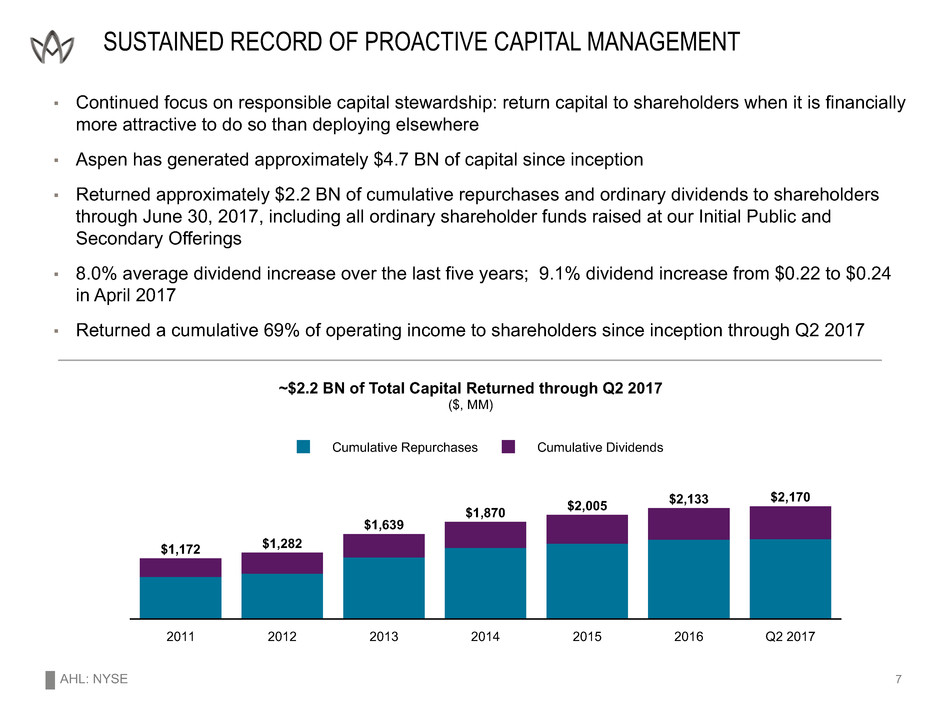
AHL: NYSE ▪ Continued focus on responsible capital stewardship: return capital to shareholders when it is financially more attractive to do so than deploying elsewhere ▪ Aspen has generated approximately $4.7 BN of capital since inception ▪ Returned approximately $2.2 BN of cumulative repurchases and ordinary dividends to shareholders through June 30, 2017, including all ordinary shareholder funds raised at our Initial Public and Secondary Offerings ▪ 8.0% average dividend increase over the last five years; 9.1% dividend increase from $0.22 to $0.24 in April 2017 ▪ Returned a cumulative 69% of operating income to shareholders since inception through Q2 2017 ~$2.2 BN of Total Capital Returned through Q2 2017 ($, MM) SUSTAINED RECORD OF PROACTIVE CAPITAL MANAGEMENT 7 Cumulative Repurchases Cumulative Dividends 2011 2012 2013 2014 2015 2016 Q2 2017 $1,172 $1,282 $1,639 $1,870 $2,005 $2,133 $2,170

AHL: NYSE 8 MULTIPLE LEVERS TO IMPROVE FINANCIAL PERFORMANCE Financial Optimization ▪ Outward Reinsurance ▪ 2014-2015: restructured ceded reinsurance and retrocession programs, utilizing internal reinsurance vehicle; achieved $23 MM net income improvement in each year ▪ 2016: shifted outward contracts to multi-line quota share and aggregate covers; expected to reduce income statement volatility and improve total expense ratio in 2017 and beyond(1) ▪ Investment Strategy ▪ 2011-2016: opportunistic adjustments to investment portfolio have enhanced net investment income return, consistent to book value per share growth ▪ Late 2016: sold $200 MM in equity securities; realizing gain on the sale and reinvested in fixed income securities in rising interest rate environment ▪ Business Optimization ▪ Through Year-End 2014: lowered U.S. Wind probable maximum losses (“PMLs”), freeing up approximately $140 MM of capital Operational Optimization ▪ 2015-2016: implemented group Targeted Operating Model (“TOM”), aimed at building scalable operations to support the business as it grows and address process efficiencies ▪ 2016: announced newly created position of Group Chief Operating Officer to add strategic vision and ensure operational activities are developed further and effectively aligned to our overall strategy and business plans (1) See "Safe Harbor Disclosure" slide 2.
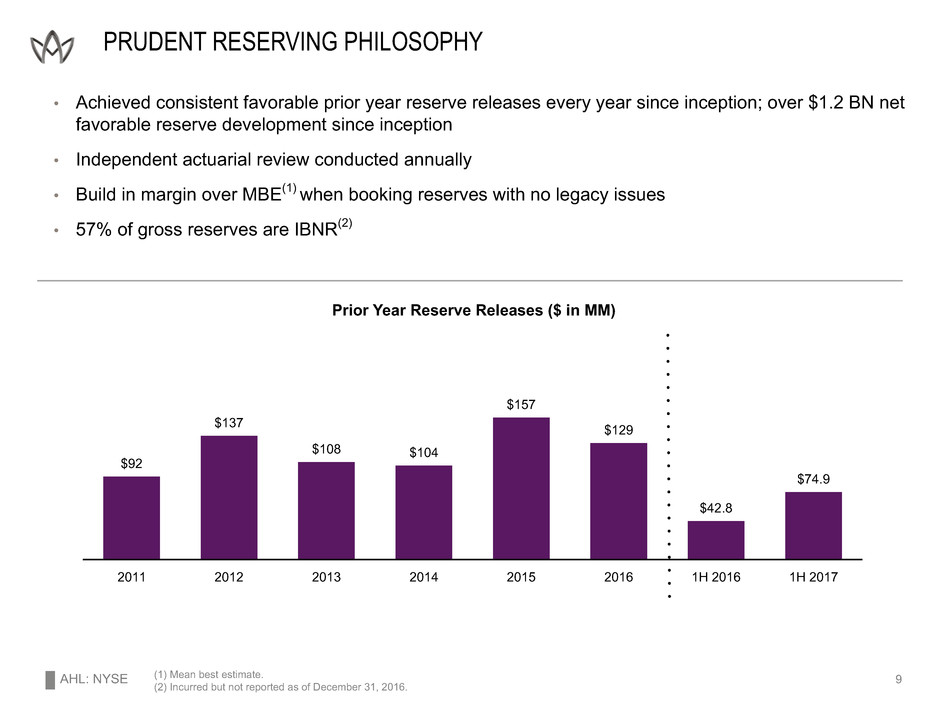
AHL: NYSE 2011 2012 2013 2014 2015 2016 1H 2016 1H 2017 $92 $137 $108 $104 $157 $129 $42.8 $74.9 PRUDENT RESERVING PHILOSOPHY • Achieved consistent favorable prior year reserve releases every year since inception; over $1.2 BN net favorable reserve development since inception • Independent actuarial review conducted annually • Build in margin over MBE(1) when booking reserves with no legacy issues • 57% of gross reserves are IBNR(2) Prior Year Reserve Releases ($ in MM) (1) Mean best estimate. (2) Incurred but not reported as of December 31, 2016. 9
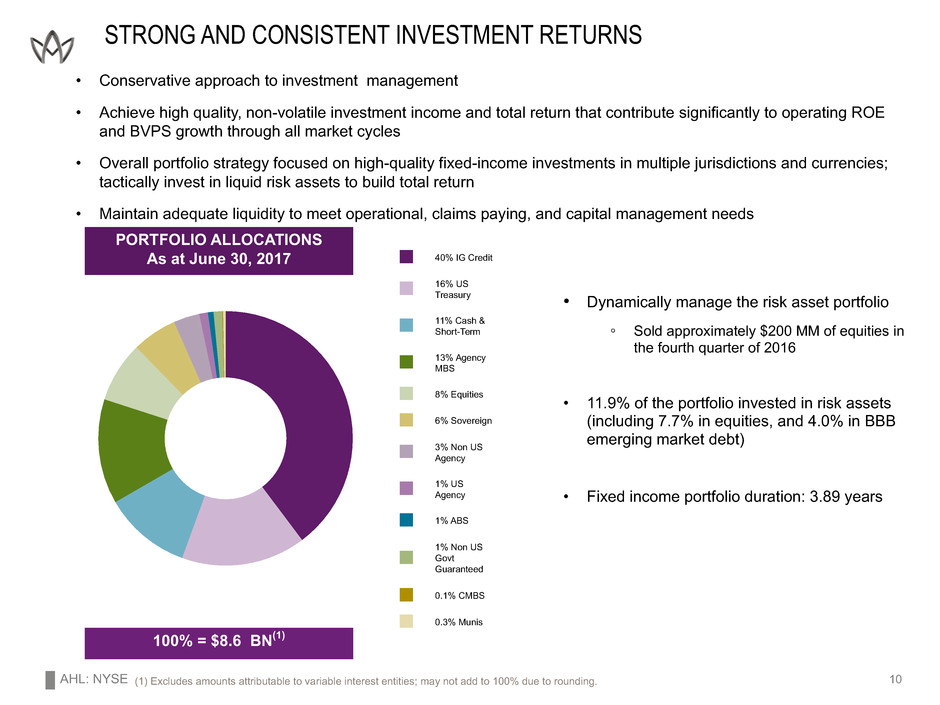
AHL: NYSE 40% IG Credit 16% US Treasury 11% Cash & Short-Term 13% Agency MBS 8% Equities 6% Sovereign 3% Non US Agency 1% US Agency 1% ABS 1% Non US Govt Guaranteed 0.1% CMBS 0.3% Munis STRONG AND CONSISTENT INVESTMENT RETURNS 100% = $8.6 BN(1) • Dynamically manage the risk asset portfolio ◦ Sold approximately $200 MM of equities in the fourth quarter of 2016 • 11.9% of the portfolio invested in risk assets (including 7.7% in equities, and 4.0% in BBB emerging market debt) • Fixed income portfolio duration: 3.89 years (1) Excludes amounts attributable to variable interest entities; may not add to 100% due to rounding. 10 • Conservative approach to investment management • Achieve high quality, non-volatile investment income and total return that contribute significantly to operating ROE and BVPS growth through all market cycles • Overall portfolio strategy focused on high-quality fixed-income investments in multiple jurisdictions and currencies; tactically invest in liquid risk assets to build total return • Maintain adequate liquidity to meet operational, claims paying, and capital management needs PORTFOLIO ALLOCATIONS As at June 30, 2017
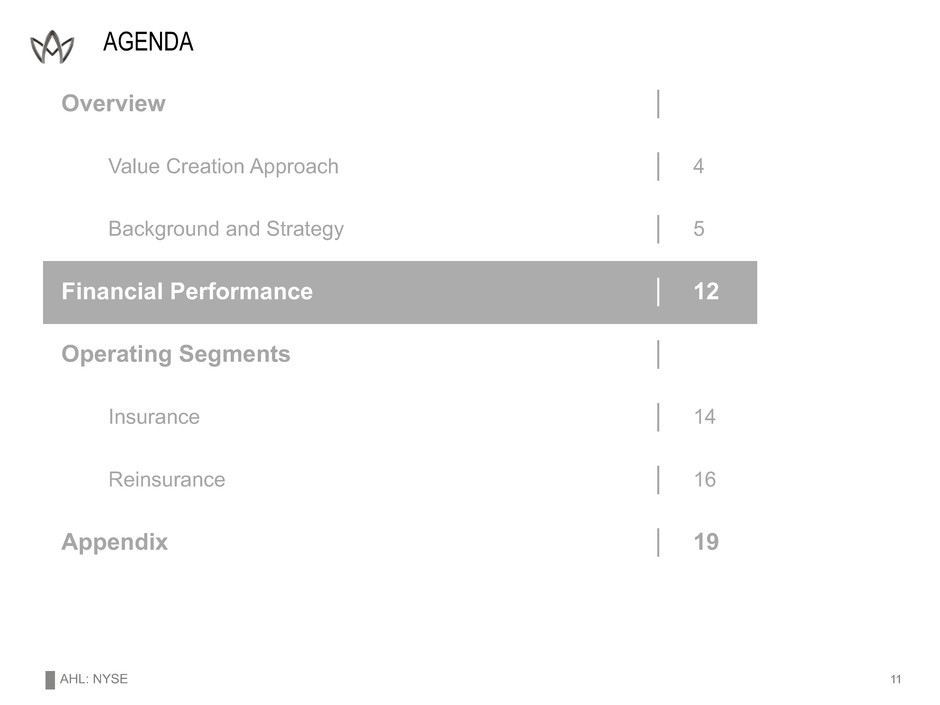
AHL: NYSE AGENDA Overview │ Value Creation Approach │ 4 Background and Strategy │ 5 Financial Performance │ 12 Operating Segments │ Insurance │ 14 Reinsurance │ 16 Appendix │ 19 11
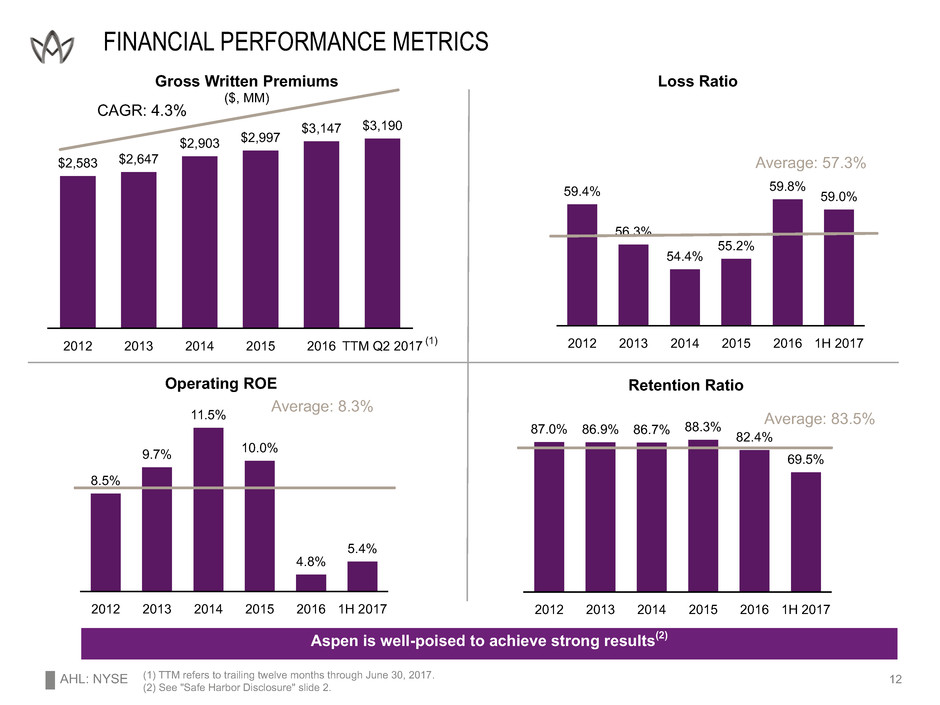
AHL: NYSE 2012 2013 2014 2015 2016 1H 2017 87.0% 86.9% 86.7% 88.3% 82.4% 69.5% 2012 2013 2014 2015 2016 1H 2017 8.5% 9.7% 11.5% 10.0% 4.8% 5.4% 2012 2013 2014 2015 2016 1H 2017 59.4% 56.3% 54.4% 55.2% 59.8% 59.0% 2012 2013 2014 2015 2016 TTM Q2 2017 $2,583 $2,647 $2,903 $2,997 $3,147 $3,190 FINANCIAL PERFORMANCE METRICS Gross Written Premiums ($, MM) Loss Ratio 12 Operating ROE (1) TTM refers to trailing twelve months through June 30, 2017. (2) See "Safe Harbor Disclosure" slide 2. CAGR: 4.3% Average: 57.3% Average: 8.3% Aspen is well-poised to achieve strong results(2) Retention Ratio Average: 83.5% (1)
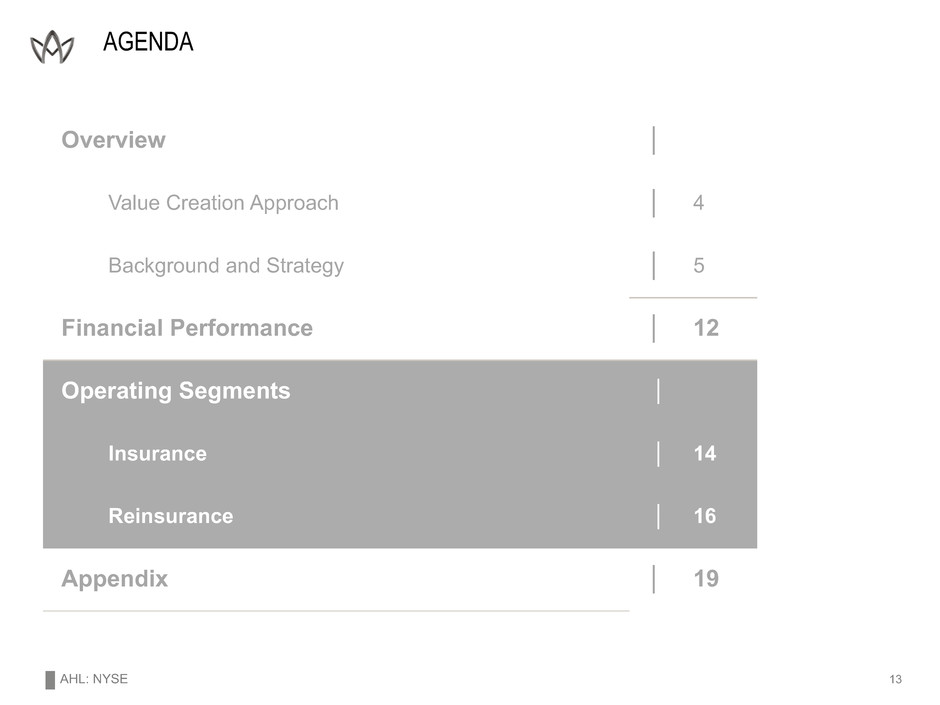
AHL: NYSE AGENDA 13 Overview │ Value Creation Approach │ 4 Background and Strategy │ 5 Financial Performance │ 12 Operating Segments │ Insurance │ 14 Reinsurance │ 16 Appendix │ 19
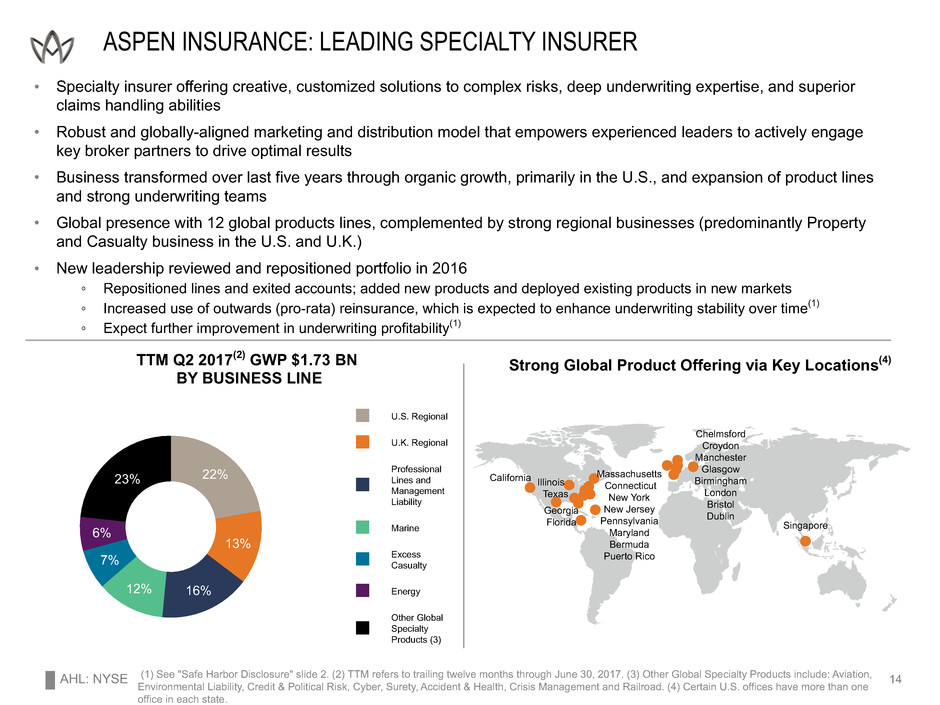
AHL: NYSE U.S. Regional U.K. Regional Professional Lines and Management Liability Marine Excess Casualty Energy Other Global Specialty Products (3) 22% 13% 16%12% 7% 6% 23% • Specialty insurer offering creative, customized solutions to complex risks, deep underwriting expertise, and superior claims handling abilities • Robust and globally-aligned marketing and distribution model that empowers experienced leaders to actively engage key broker partners to drive optimal results • Business transformed over last five years through organic growth, primarily in the U.S., and expansion of product lines and strong underwriting teams • Global presence with 12 global products lines, complemented by strong regional businesses (predominantly Property and Casualty business in the U.S. and U.K.) • New leadership reviewed and repositioned portfolio in 2016 ◦ Repositioned lines and exited accounts; added new products and deployed existing products in new markets ◦ Increased use of outwards (pro-rata) reinsurance, which is expected to enhance underwriting stability over time(1) ◦ Expect further improvement in underwriting profitability(1) TTM Q2 2017(2) GWP $1.73 BN BY BUSINESS LINE ASPEN INSURANCE: LEADING SPECIALTY INSURER (1) See "Safe Harbor Disclosure" slide 2. (2) TTM refers to trailing twelve months through June 30, 2017. (3) Other Global Specialty Products include: Aviation, Environmental Liability, Credit & Political Risk, Cyber, Surety, Accident & Health, Crisis Management and Railroad. (4) Certain U.S. offices have more than one office in each state. 14 Strong Global Product Offering via Key Locations(4) Singapore California Georgia Florida Chelmsford Croydon Manchester Glasgow Birmingham London Bristol Dublin Illinois Massachusetts Connecticut New York New Jersey Pennsylvania Maryland Bermuda Puerto Rico Texas
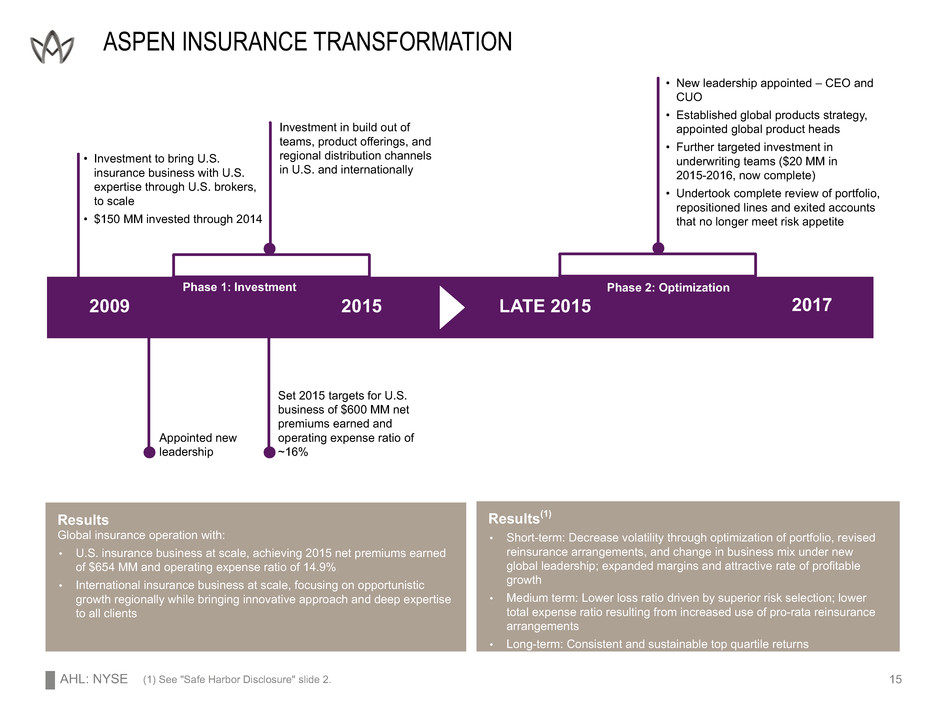
AHL: NYSE 15(1) See "Safe Harbor Disclosure" slide 2. ASPEN INSURANCE TRANSFORMATION • Investment to bring U.S. insurance business with U.S. expertise through U.S. brokers, to scale • $150 MM invested through 2014 Appointed new leadership Investment in build out of teams, product offerings, and regional distribution channels in U.S. and internationally Set 2015 targets for U.S. business of $600 MM net premiums earned and operating expense ratio of ~16% • New leadership appointed – CEO and CUO • Established global products strategy, appointed global product heads • Further targeted investment in underwriting teams ($20 MM in 2015-2016, now complete) • Undertook complete review of portfolio, repositioned lines and exited accounts that no longer meet risk appetite Results Global insurance operation with: • U.S. insurance business at scale, achieving 2015 net premiums earned of $654 MM and operating expense ratio of 14.9% • International insurance business at scale, focusing on opportunistic growth regionally while bringing innovative approach and deep expertise to all clients Results(1) • Short-term: Decrease volatility through optimization of portfolio, revised reinsurance arrangements, and change in business mix under new global leadership; expanded margins and attractive rate of profitable growth • Medium term: Lower loss ratio driven by superior risk selection; lower total expense ratio resulting from increased use of pro-rata reinsurance arrangements • Long-term: Consistent and sustainable top quartile returns Phase 1: Investment 2015 LATE 20152009 2017 Phase 2: OptimizationPhase 1: Investment
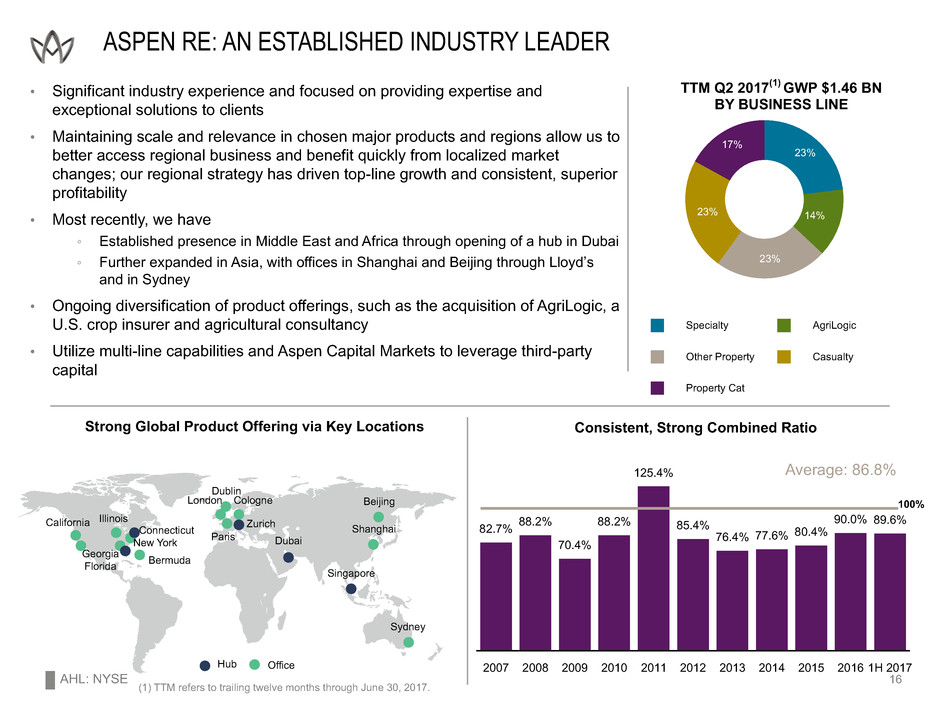
AHL: NYSE 2007 2008 2009 2010 2011 2012 2013 2014 2015 2016 1H 2017 82.7% 88.2% 70.4% 88.2% 125.4% 85.4% 76.4% 77.6% 80.4% 90.0% 89.6% Specialty AgriLogic Other Property Casualty Property Cat 23% 14% 23% 23% 17% 16 • Significant industry experience and focused on providing expertise and exceptional solutions to clients • Maintaining scale and relevance in chosen major products and regions allow us to better access regional business and benefit quickly from localized market changes; our regional strategy has driven top-line growth and consistent, superior profitability • Most recently, we have ◦ Established presence in Middle East and Africa through opening of a hub in Dubai ◦ Further expanded in Asia, with offices in Shanghai and Beijing through Lloyd’s and in Sydney • Ongoing diversification of product offerings, such as the acquisition of AgriLogic, a U.S. crop insurer and agricultural consultancy • Utilize multi-line capabilities and Aspen Capital Markets to leverage third-party capital Strong Global Product Offering via Key Locations Consistent, Strong Combined Ratio Shanghai Sydney Singapore Dubai California BermudaGeorgiaFlorida London Cologne Zurich Paris ConnecticutNew York Illinois TTM Q2 2017(1) GWP $1.46 BN BY BUSINESS LINE ASPEN RE: AN ESTABLISHED INDUSTRY LEADER Average: 86.8% Dublin Beijing Hub Office 100% (1) TTM refers to trailing twelve months through June 30, 2017.
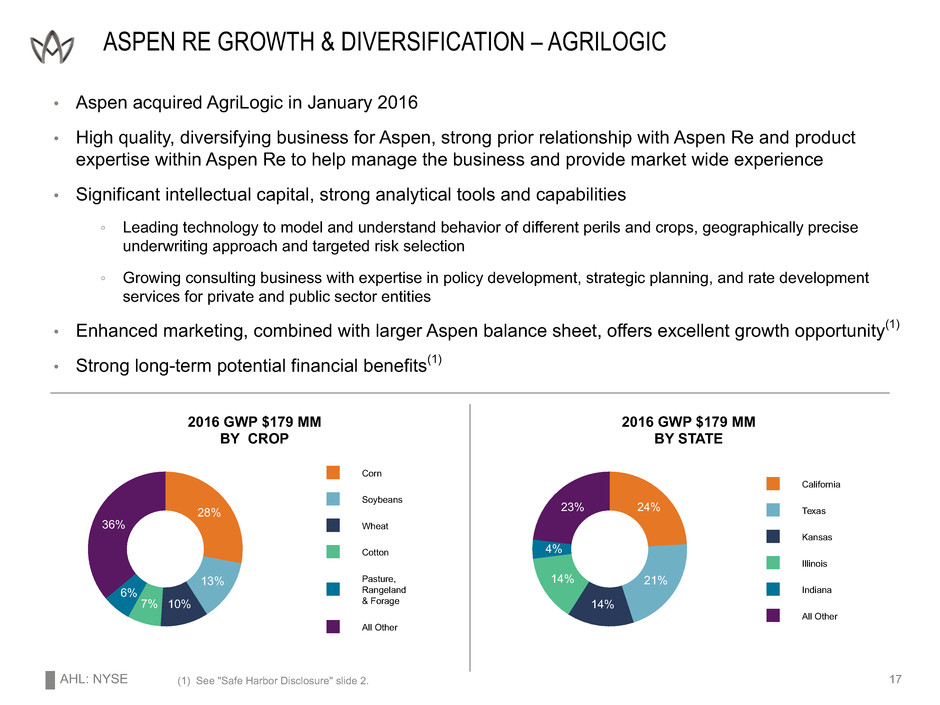
AHL: NYSE • Aspen acquired AgriLogic in January 2016 • High quality, diversifying business for Aspen, strong prior relationship with Aspen Re and product expertise within Aspen Re to help manage the business and provide market wide experience • Significant intellectual capital, strong analytical tools and capabilities ◦ Leading technology to model and understand behavior of different perils and crops, geographically precise underwriting approach and targeted risk selection ◦ Growing consulting business with expertise in policy development, strategic planning, and rate development services for private and public sector entities • Enhanced marketing, combined with larger Aspen balance sheet, offers excellent growth opportunity(1) • Strong long-term potential financial benefits(1) 2016 GWP $179 MM BY CROP 2016 GWP $179 MM BY STATE ASPEN RE GROWTH & DIVERSIFICATION – AGRILOGIC (1) See "Safe Harbor Disclosure" slide 2. 17 Corn Soybeans Wheat Cotton Pasture, Rangeland & Forage All Other 28% 13% 10%7% 6% 36% California Texas Kansas Illinois Indiana All Other 24% 21% 14% 14% 4% 23%
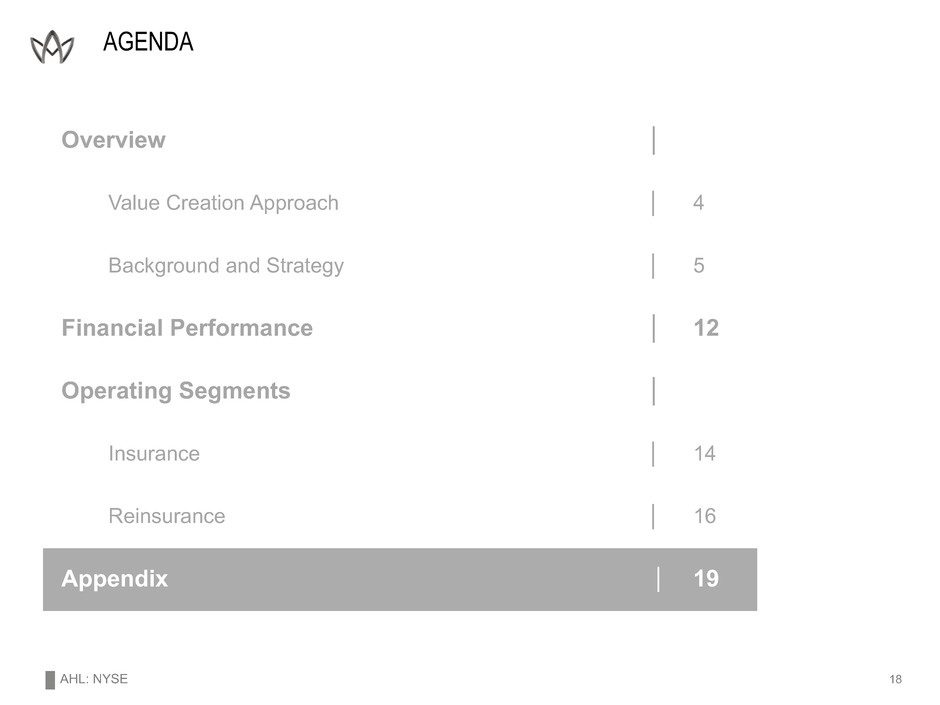
AHL: NYSE AGENDA 18 Overview │ Value Creation Approach │ 4 Background and Strategy │ 5 Financial Performance │ 12 Operating Segments │ Insurance │ 14 Reinsurance │ 16 Appendix │ 19
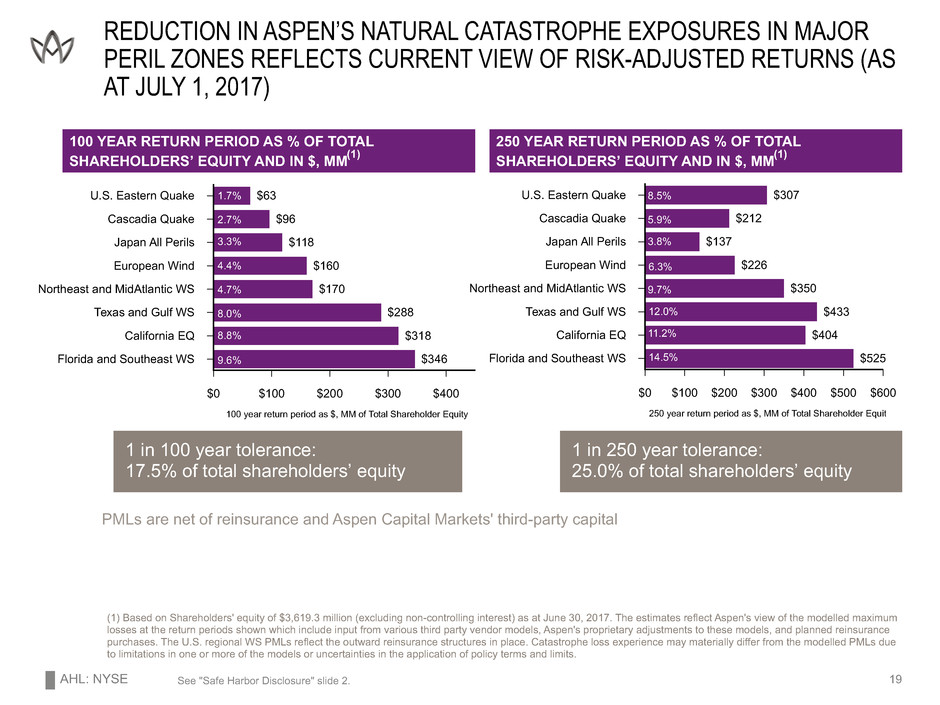
AHL: NYSE $0 $100 $200 $300 $400 100 year return period as $, MM of Total Shareholder Equity U.S. Eastern Quake Cascadia Quake Japan All Perils European Wind Northeast and MidAtlantic WS Texas and Gulf WS California EQ Florida and Southeast WS $63 $96 $118 $160 $170 $288 $318 $346 $0 $100 $200 $300 $400 $500 $600 250 year return period as $, MM of Total Shareholder Equity U.S. Eastern Quake Cascadia Quake Japan All Perils European Wind Northeast and MidAtlantic WS Texas and Gulf WS California EQ Florida and Southeast WS $307 $212 $137 $226 $350 $433 $404 $525 REDUCTION IN ASPEN’S NATURAL CATASTROPHE EXPOSURES IN MAJOR PERIL ZONES REFLECTS CURRENT VIEW OF RISK-ADJUSTED RETURNS (AS AT JULY 1, 2017) 100 YEAR RETURN PERIOD AS % OF TOTAL SHAREHOLDERS’ EQUITY AND IN $, MM(1) 250 YEAR RETURN PERIOD AS % OF TOTAL SHAREHOLDERS’ EQUITY AND IN $, MM(1) 1 in 100 year tolerance: 17.5% of total shareholders’ equity 1 in 250 year tolerance: 25.0% of total shareholders’ equity PMLs are net of reinsurance and Aspen Capital Markets' third-party capital (1) Based on Shareholders' equity of $3,619.3 million (excluding non-controlling interest) as at June 30, 2017. The estimates reflect Aspen's view of the modelled maximum losses at the return periods shown which include input from various third party vendor models, Aspen's proprietary adjustments to these models, and planned reinsurance purchases. The U.S. regional WS PMLs reflect the outward reinsurance structures in place. Catastrophe loss experience may materially differ from the modelled PMLs due to limitations in one or more of the models or uncertainties in the application of policy terms and limits. See "Safe Harbor Disclosure" slide 2. 19 1.7% 2.7% 3.3% 4.4% 4.7% 8.0% 8.8% 9.6% 8.5% 5.9% 3.8% 6.3% 9.7% 12.0% 11.2% 14.5%
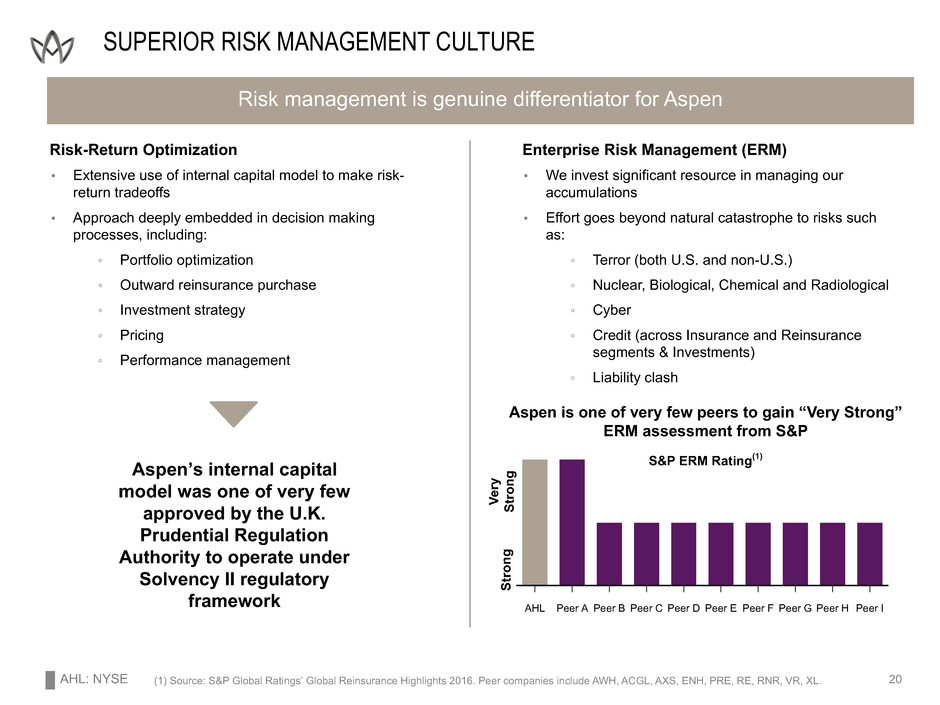
AHL: NYSE Risk management is genuine differentiator for Aspen SUPERIOR RISK MANAGEMENT CULTURE Aspen’s internal capital model was one of very few approved by the U.K. Prudential Regulation Authority to operate under Solvency II regulatory framework Risk-Return Optimization • Extensive use of internal capital model to make risk- return tradeoffs • Approach deeply embedded in decision making processes, including: ◦ Portfolio optimization ◦ Outward reinsurance purchase ◦ Investment strategy ◦ Pricing ◦ Performance management Enterprise Risk Management (ERM) • We invest significant resource in managing our accumulations • Effort goes beyond natural catastrophe to risks such as: ◦ Terror (both U.S. and non-U.S.) ◦ Nuclear, Biological, Chemical and Radiological ◦ Cyber ◦ Credit (across Insurance and Reinsurance segments & Investments) ◦ Liability clash Aspen is one of very few peers to gain “Very Strong” ERM assessment from S&P S&P ERM Rating(1) Stron g Ver y Stron g (1) Source: S&P Global Ratings’ Global Reinsurance Highlights 2016. Peer companies include AWH, ACGL, AXS, ENH, PRE, RE, RNR, VR, XL. 20 AHL Peer A Peer B Peer C Peer D Peer E Peer F Peer G Peer H Peer I



















